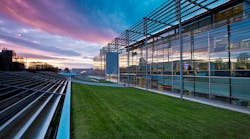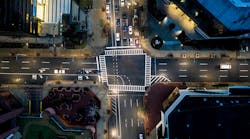It's not the first time that the impact of white solid-state light (SSL) on human health has been questioned, but a new research project says that LEDs, for the same photopic flux output, increase "pollution in the scotopic and melatonin suppression bands" by five times relative to high-pressure-sodium (HPS) sources. The publication originating from institutions in Italy, Israel, and the US recommends regulatory limits for future SSL products.
The research entitled "Limiting the impact of light pollution on human health, environment, and stellar visibility" was published in the Journal of Environmental Management. The authors include Fabio Falchi of Italy's Light Pollution Science and Technology Institute (ISTIL), Christopher Elvidge of the National Geophysical Data Center in Boulder, CO, David Keith of Marshall Design in Boulder, and Abraham Haim of Israel's University of Haifa.
The research studied both LED and metal-halide (MH) sources relative to reference HPS sources. Both the LED and MH sources produce white light that includes more blue content at shorter wavelengths than do HPS sources that produce orange- to yellow-tinted light. Like much similar research, the new study apparently didn't test actual subjects, but rather relied on prior research on melatonin-suppression levels relative to spectral content. The researchers came to the conclusion that MH lights suppress melatonin at a rate 3 times greater than HPS lights and LEDs suppress melatonin at 5 times the HPS rate.
The magnitude of the impact of melatonin suppression remains in debate. The secretion of melatonin has been shown as key in normal sleep/wake cycles and circadian rhythms. Some researchers also believe that it has "anti-oxidant and anti-cancerous" properties as the new research points out.
Dueling studies
Unfortunately there is lack of conclusive data on the impact of white light at night. Just how bad is such light for us at night, and how much does it take to adversely impact humans and animals?
Last year, the Lighting Research Center (LRC) at Rensselaer Polytechnic Institute (RPI) published a paper on the impact of lighting on the circadian system as part of its Alliance for Solid-State Illumination and Technologies (ASSIST) series. That research found that typical night-time exposure to white light could suppress melatonin, but at a level far below the 15% threshold that the LR researchers consider problematic. The LRC research was based on a 20-year-old person exposed to light in a typical outdoor scenario for one hour.
The LRC study came after a number of environmentalists had raised concerns over night lighting with a prevalence of blue wavelengths. Indeed the International Dark-Sky Association (IDA) had campaigned vigorously against broad use of LED sources. The IDA had raised health concerns as an issue although they clearly have many members that are more worried about recreational endeavors such as astronomy.
The IDA has subsequently worked with the SSL and general-lighting industry developing the Model Lighting Ordinance (MLO) to help communities set reasonable standards for night-light levels. The MLO accepts SSL as perfectly acceptable although it does set standards for color temperature and more importantly strictly limits up-light pollution and unacceptably high levels at ground level.
Given developments such as the MLO, the timing of the new study is bit surprising given that most outdoor SSL installations get positive marks in all areas other than upfront costs. But the authors of the paper have strong words about future SSL products.
Researchers' strong opinions
"As a first step in Israel, for example, the Standards Institution of Israel should obligate bulb importers to state clearly on their packaging what wavelengths are produced by each bulb," said Haim of the University of Haifa. "If wavelength indeed influences melatonin production, this is information that needs to be brought to the public’s attention, so consumers can decide whether to buy this lighting or not."
"Most regions in Italy have legislations to lower the impact of light pollution, but they still lack a regulation on the spectrum emitted by lamps," said ISTIL's Falchi. "Unless legislation is updated soon, with the current trend toward sources as white LEDs, which emit a huge amount of blue light, we will enter a period of elevated negative effects of light at night on human health and environment. Lamp manufacturers cannot claim that they don’t know about the consequences of artificial light at night."
There is sure to be commentary aplenty about the new research. The world is moving toward an understanding that we often over-light areas for a variety of reasons. That's the first line of defense against any adverse effect of nighttime light and efforts such as the MLO is combating that trend. Moreover, SSL products have significantly warmer color temperatures with proportionally-less blue content than was present even a year ago. Those two trends bode well for a continued escalation of SSL.




